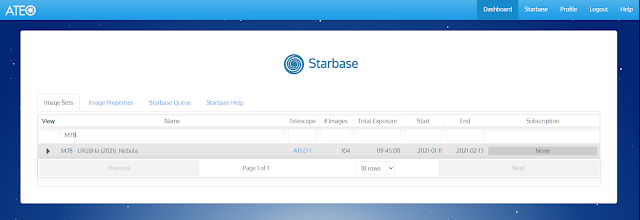In this post, Insight Observatory features deep-sky object Messier 78. This target was requested to be added to Insight Observatory's image set repository, Starbase by one of its loyal Starbase subscribers.
The image set data was acquired on the 16" f/3.75 Dream Aerospace Systems astrograph reflector (ATEO-1) remote telescope located in New Mexico. There are nearly 10 hours of Luminance, Red, Blue, Green, and Ha image data of Messier 78 available for download on Starbase.
Messier 78 or M78, also known as NGC 2068, is a reflection nebula in the constellation Orion. The nebula was discovered by Pierre Méchain in 1780 and included by Charles Messier in his catalog of comet-like objects that same year.
M78 is the brightest diffuse reflection nebula of a group of nebulae that includes NGC 2064, NGC 2067, and NGC 2071. This group belongs to the Orion B molecular cloud complex and is about 1,350 light-years distant from Earth. Messier 78 is easily found in small telescopes as a hazy patch and involves two stars of 10th and 11th magnitude. These two B-type stars, HD 38563 A and HD 38563 B, are responsible for making the cloud of dust in M78 visible by reflecting their light.
Source: Wikipedia
Insight Observatory is currently taking deep-sky image requests for Starbase image sets on its new ATEO Portal dashboard. There is no charge for these requests. If the requests are approved by the Insight Observatory staff, they will be imaged and uploaded to Starbase for anyone to subscribe to for the low rate of $0.05 (cents) USD per imaging minute for standard subscribers and $0.04 (cents) USD for educational subscribers. We only ask that Starbase subscription requests are for at least 5 hours of integration time.
Read More
The image set data was acquired on the 16" f/3.75 Dream Aerospace Systems astrograph reflector (ATEO-1) remote telescope located in New Mexico. There are nearly 10 hours of Luminance, Red, Blue, Green, and Ha image data of Messier 78 available for download on Starbase.
 |
| Messier 78 reflection nebula located in the constellation Orion imaged on ATEO-1 and processed by Utkarsh Mishra. The image set is now available for download on Starbase. |
Messier 78 or M78, also known as NGC 2068, is a reflection nebula in the constellation Orion. The nebula was discovered by Pierre Méchain in 1780 and included by Charles Messier in his catalog of comet-like objects that same year.
M78 is the brightest diffuse reflection nebula of a group of nebulae that includes NGC 2064, NGC 2067, and NGC 2071. This group belongs to the Orion B molecular cloud complex and is about 1,350 light-years distant from Earth. Messier 78 is easily found in small telescopes as a hazy patch and involves two stars of 10th and 11th magnitude. These two B-type stars, HD 38563 A and HD 38563 B, are responsible for making the cloud of dust in M78 visible by reflecting their light.
Source: Wikipedia
 |
| Search for M78 in the "Name" field in Starbase and access to the M78 LRGBHa (2021) Nebula image set will display. |
Insight Observatory is currently taking deep-sky image requests for Starbase image sets on its new ATEO Portal dashboard. There is no charge for these requests. If the requests are approved by the Insight Observatory staff, they will be imaged and uploaded to Starbase for anyone to subscribe to for the low rate of $0.05 (cents) USD per imaging minute for standard subscribers and $0.04 (cents) USD for educational subscribers. We only ask that Starbase subscription requests are for at least 5 hours of integration time.



